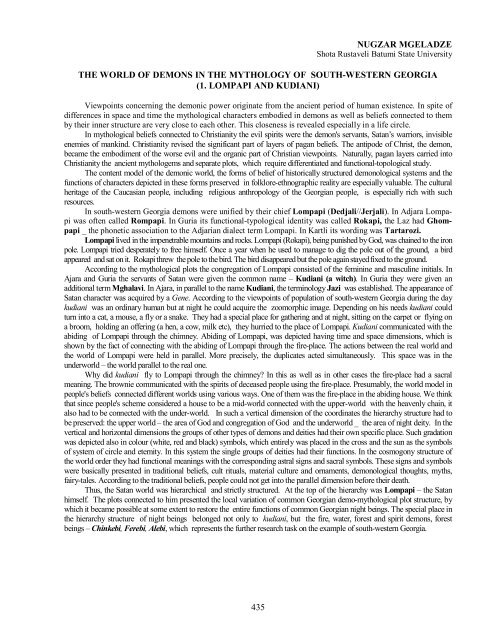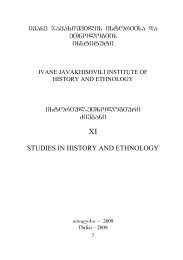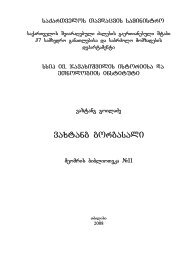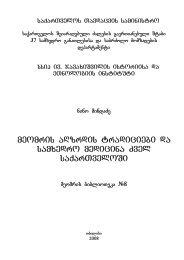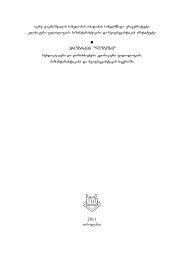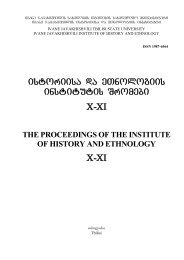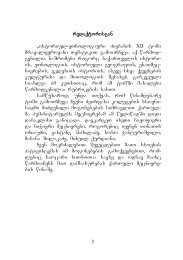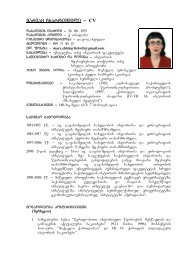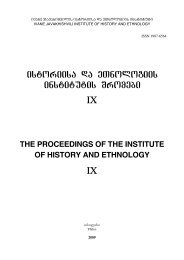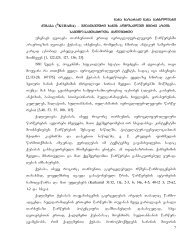axali da uaxlesi istoria
axali da uaxlesi istoria
axali da uaxlesi istoria
You also want an ePaper? Increase the reach of your titles
YUMPU automatically turns print PDFs into web optimized ePapers that Google loves.
NUGZAR MGELADZE<br />
Shota Rustaveli Batumi State University<br />
THE WORLD OF DEMONS IN THE MYTHOLOGY OF SOUTH-WESTERN GEORGIA<br />
(1. LOMPAPI AND KUDIANI)<br />
Viewpoints concerning the demonic power originate from the ancient period of human existence. In spite of<br />
differences in space and time the mythological characters embodied in demons as well as beliefs connected to them<br />
by their inner structure are very close to each other. This closeness is revealed especially in a life circle.<br />
In mythological beliefs connected to Christianity the evil spirits were the demon's servants, Satan’s warriors, invisible<br />
enemies of mankind. Christianity revised the significant part of layers of pagan beliefs. The antipode of Christ, the demon,<br />
became the embodiment of the worse evil and the organic part of Christian viewpoints. Naturally, pagan layers carried into<br />
Christianity the ancient mythologems and separate plots, which require differentiated and functional-topological study.<br />
The content model of the demonic world, the forms of belief of historically structured demonological systems and the<br />
functions of characters depicted in these forms preserved in folklore-ethnographic reality are especially valuable. The cultural<br />
heritage of the Caucasian people, including religious anthropology of the Georgian people, is especially rich with such<br />
resources.<br />
In south-western Georgia demons were unified by their chief Lompapi (Dedjali//Jerjali). In Adjara Lompapi<br />
was often called Rompapi. In Guria its functional-typological identity was called Rokapi, the Laz had Ghompapi<br />
_ the phonetic association to the Adjarian dialect term Lompapi. In Kartli its wording was Tartarozi.<br />
Lompapi lived in the impenetrable mountains and rocks. Lompapi (Rokapi), being punished by God, was chained to the iron<br />
pole. Lompapi tried desperately to free himself. Once a year when he used to manage to dig the pole out of the ground, a bird<br />
appeared and sat on it. Rokapi threw the pole to the bird. The bird disappeared but the pole again stayed fixed to the ground.<br />
According to the mythological plots the congregation of Lompapi consisted of the feminine and masculine initials. In<br />
Ajara and Guria the servants of Satan were given the common name – Kudiani (a witch). In Guria they were given an<br />
additional term Mghalavi. In Ajara, in parallel to the name Kudiani, the terminology Jazi was established. The appearance of<br />
Satan character was acquired by a Gene. According to the viewpoints of population of south-western Georgia during the <strong>da</strong>y<br />
kudiani was an ordinary human but at night he could acquire the zoomorphic image. Depending on his needs kudiani could<br />
turn into a cat, a mouse, a fly or a snake. They had a special place for gathering and at night, sitting on the carpet or flying on<br />
a broom, holding an offering (a hen, a cow, milk etc), they hurried to the place of Lompapi. Kudiani communicated with the<br />
abiding of Lompapi through the chimney. Abiding of Lompapi, was depicted having time and space dimensions, which is<br />
shown by the fact of connecting with the abiding of Lompapi through the fire-place. The actions between the real world and<br />
the world of Lompapi were held in parallel. More precisely, the duplicates acted simultaneously. This space was in the<br />
underworld – the world parallel to the real one.<br />
Why did kudiani fly to Lompapi through the chimney? In this as well as in other cases the fire-place had a sacral<br />
meaning. The brownie communicated with the spirits of deceased people using the fire-place. Presumably, the world model in<br />
people's beliefs connected different worlds using various ways. One of them was the fire-place in the abiding house. We think<br />
that since people's scheme considered a house to be a mid-world connected with the upper-world with the heavenly chain, it<br />
also had to be connected with the under-world. In such a vertical dimension of the coordinates the hierarchy structure had to<br />
be preserved: the upper world – the area of God and congregation of God and the underworld _ the area of night deity. In the<br />
vertical and horizontal dimensions the groups of other types of demons and deities had their own specific place. Such gra<strong>da</strong>tion<br />
was depicted also in colour (white, red and black) symbols, which entirely was placed in the cross and the sun as the symbols<br />
of system of circle and eternity. In this system the single groups of deities had their functions. In the cosmogony structure of<br />
the world order they had functional meanings with the corresponding astral signs and sacral symbols. These signs and symbols<br />
were basically presented in traditional beliefs, cult rituals, material culture and ornaments, demonological thoughts, myths,<br />
fairy-tales. According to the traditional beliefs, people could not get into the parallel dimension before their death.<br />
Thus, the Satan world was hierarchical and strictly structured. At the top of the hierarchy was Lompapi – the Satan<br />
himself. The plots connected to him presented the local variation of common Georgian demo-mythological plot structure, by<br />
which it became possible at some extent to restore the entire functions of common Georgian night beings. The special place in<br />
the hierarchy structure of night beings belonged not only to kudiani, but the fire, water, forest and spirit demons, forest<br />
beings – Chinkebi, Ferebi, Alebi, which represents the further research task on the example of south-western Georgia.<br />
435


